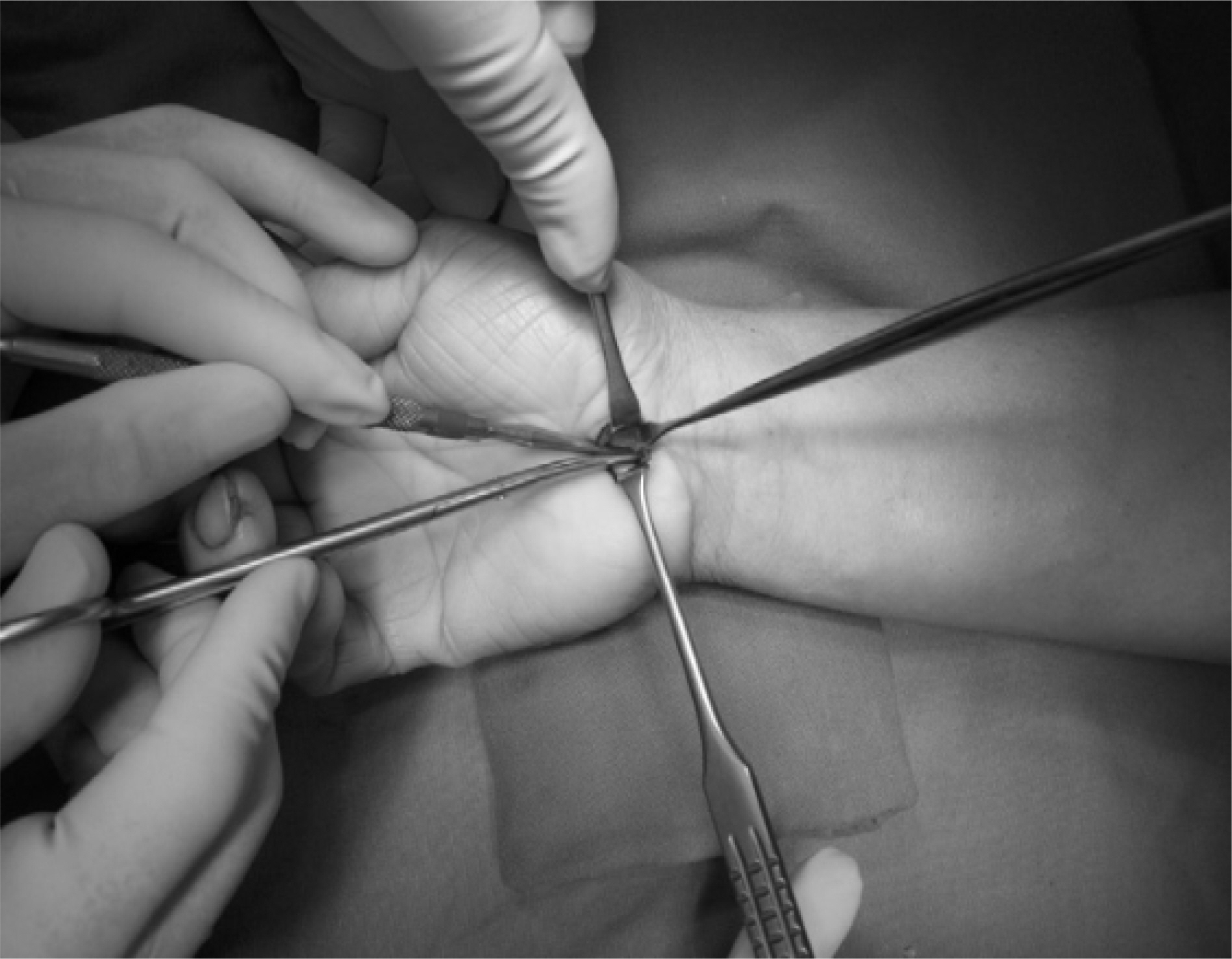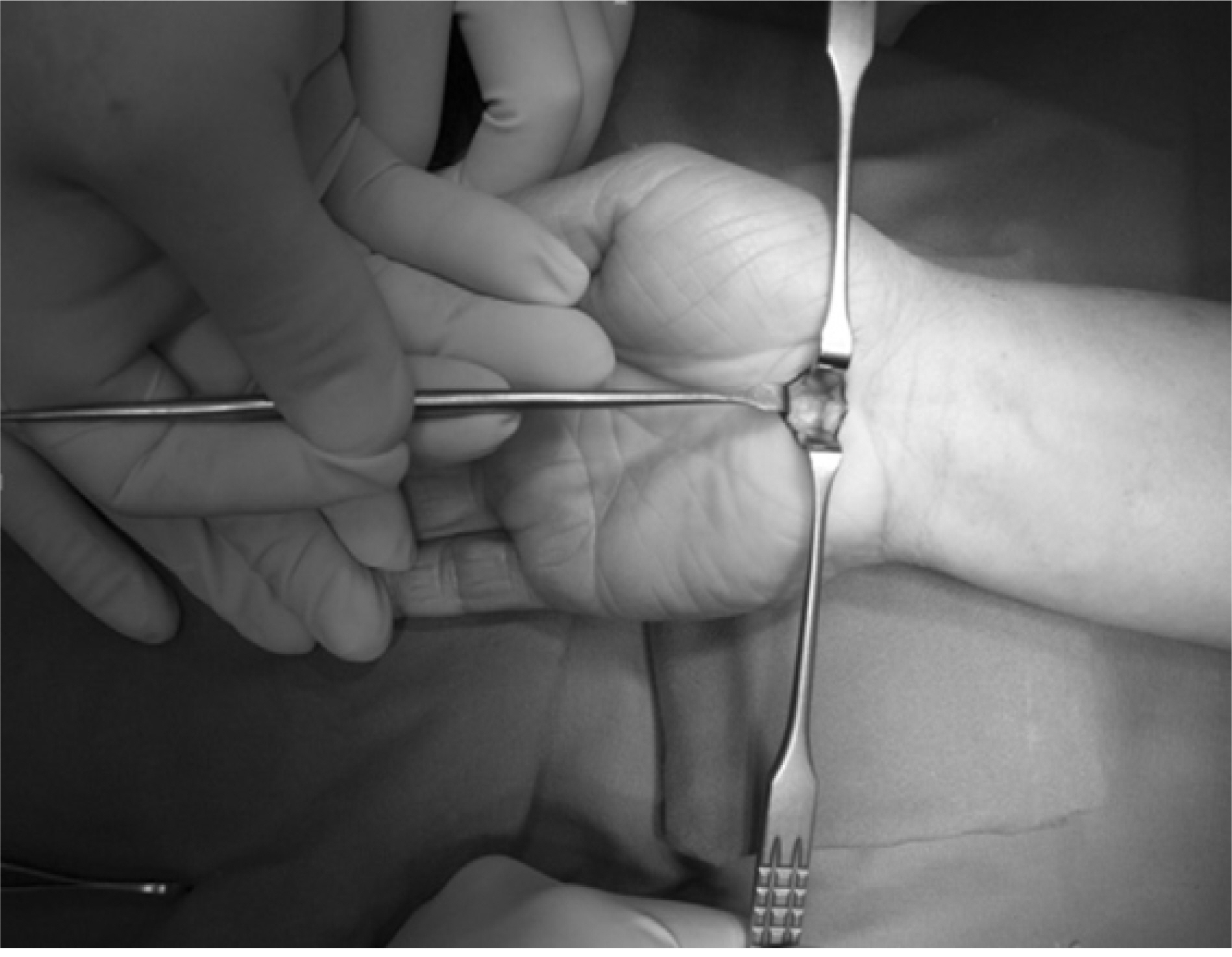Kosin Med J.
2013 Jun;28(1):13-18. 10.7180/kmj.2013.28.1.13.
The Efficacy of Carpal Tunnel Release with Mini-Open Incision
- Affiliations
-
- 1Department of Orthopaedic Surgery, Kosin University Gospel Hospital, Busan, Korea. handkwon@hotmail.com
- KMID: 2308506
- DOI: http://doi.org/10.7180/kmj.2013.28.1.13
Abstract
OBJECTIVES
We evaluated the effects of carpal tunnel release with a mini-open incision by analyzing symptom improvement.
METHODS
We retrospectively reviewed 64 carpal tunnel syndrome patients who underwent carpal tunnel release with mini-open incisions between January 2001 and December 2010. The 22 males and 42 females had a mean age of 49 years and a mean follow-up of 12 months. We analyzed postoperative symptoms using The Michigan Hand Outcome Questionnaire.
RESULTS
Patients reported complete resolution of their symptoms, and some patients who had presented with residual symptoms improved gradually. No complications or scar hypersensitivity were observed. MHQ(Michigan Hand outcomes Questionnaire) scores improved significantly between preoperative and postoperative 6 months and 12 months.
CONCLUSIONS
Carpal tunnel release with mini-open incision provides a clinically effective, reliable and safe procedure.
MeSH Terms
Figure
Reference
-
1.Biyani A., Downes EM. An open twin incision technique of carpal tunnel decompression with reduced incidence of scar tenderness. J Hand Surg Br. 1993. 18:331–4.
Article2.Bromley GS. Minimal-incision open carpal tunnel decompression. J Hand Surg Am. 1994. 19:119–20.
Article3.Serra JM., Benito JR., Monner J. Carpal tunnel release with short incision. Plast Resconstr Surg. 1997. 99:129–35.
Article4.Cellocco P., Rossi C., Bizzarri F., Patrizio L., Costanczo G. Mini-open blind precedure versus limited open technique for carpal tunnel release: a 30 month follow-up study. J Hand Surg Am. 2005. 30:493–9.5.Szabo RM., Gelberman RH., Dimick MP. Sensibility testing in patients with carpal tunnel syndrome. J Bone Joint Surg Am. 1984. 66:60–4.
Article6.Phalen GS. The carpal tunnel Syndrome. Seventeen years experience in diagnosis and treatment of six hundred fifty-four hands. J Bone Joint Surg Am. 1996. 48:211–28.7.Chung KC., Hanmill JB., Walters MR., Hayward RA. The Michigan Hand Outcome Questionnaire (MHQ): assessment of responsiveness to clinical change. Ann Plast Surg. 1999. 42:619–22.8.Paget J. Lectures on surgical pathology. Lindsay and Blakiston published 1854. p.700.9.Learmonth JR. The principle of decompression in the treatment of certain disorders of peripheral nerves. Surg Clin North Am. 1933. 13:905–13.10.PHALEN GS. Spontaneous compression of the median nerve at the wirst. J Am Med Assoc. 1951. 145:1128–33.11.Yoo JD., Yun YH., Jung JM., Kim JH., Ko YD., Jung WC. Carpal tunnel release in the Bilateral carpal tunnel syndrome. J Korean Soc Surg Hand. 2003. 8:56–9.12.Okutsu I., Ninomiya S., Hamanaka I., Kuroshima N., Inanami H. Measurement of pressure in the carpal canal before and after endoscopic management of carpal tunnel syndrome. J Bone Joint Surg Am. 1989. 71:679–83.
Article13.Berger RA. Endoscopic carpal tunnel release. A current perspective. Hand Clin. 1994. 10:625–36.14.Agee JM., McCarrol HR., North ER. Endoscopic carpal tunnel release using the single proximal incision technique. Hand Clin. 1994. 10:647–59.
Article15.Chow JC. Endoscopic carpal tunnel release. Clin Sports Med. 1996. 15:769–84.
Article16.Shinya K., Lanzetta M., Conolly WB. Risk and complications in endoscopic carpal tunnel release. J Hand Surg Br. 1995. 20:222–7.
Article17.Tountas CP., MacDonald CJ., Meyerhoff JD., Bihrle DM. Carpal tunnel syndrome. A review of 507 patients. Minn Med. 1983. 66:479–82.18.Ariyan S., Watson HK. The palmar approach for the visualization and release of the carpal tunnel. An analysis of 429 cases. Plast Reconstr Surg. 1977. 60:539–47.19.Kim JS., Shin KS., Lee DH., Jang IH., Kim YH. Endoscopic release of carpal tunnel syndrome. J Korean Orthop Assoc. 1999. 34:447–552.20.Berger RA. Endoscopic carpal tunnel release. A current perspective. Hand Clin. 1994. 10:625–36.21.Chow JC. Endoscopic carpal tunnel release. Two-portal technique. Hand Clin. 1994. 10:637–46.22.Feinstein PA. Endoscopic carpal tunnel release in community-based series. J Hand Surg Am. 1993. 18:451–4.23.Kim JS., Shin KS., Lee DH., Jang IH., Kim YH. Endoscopic release of carpal tunnel syndrome. J Korean Orthop assoc. 1999. 34:447–552.24.Bande S., De Smet L., Fabry G. The result of carpal tunnel release: Open versus endoscopic technique. J Hand Surg Br. 1994. 19:14–7.25.Ferdinand RD., MacLean JG. Endoscopic versus open carpal tunnel release in bilateral carpal tunnel syndrome. A prospective, randomised, blinded assessment. J Bone Joint Surg Br. 2002. 84:375–9.




